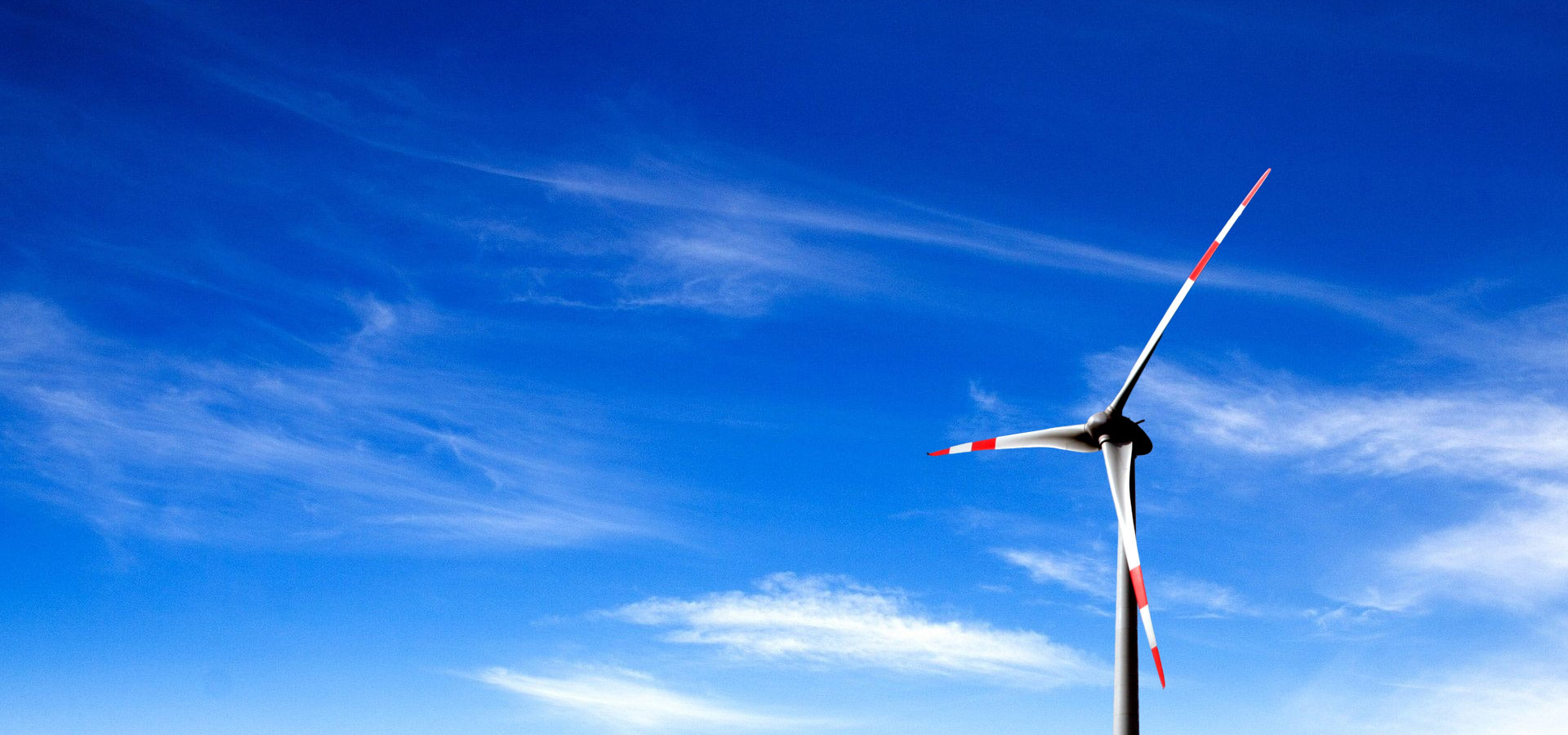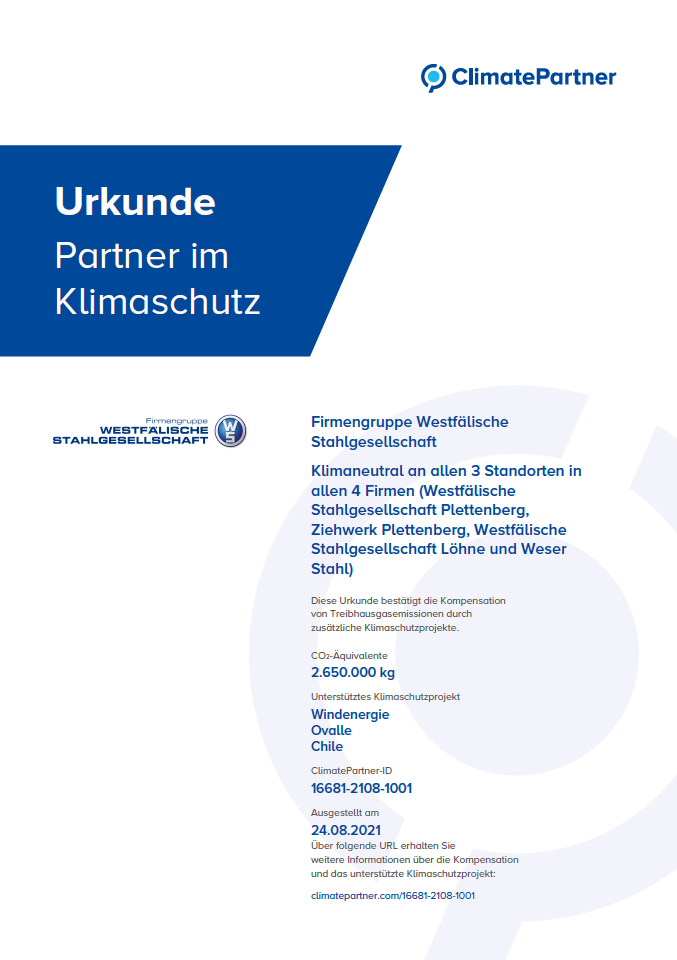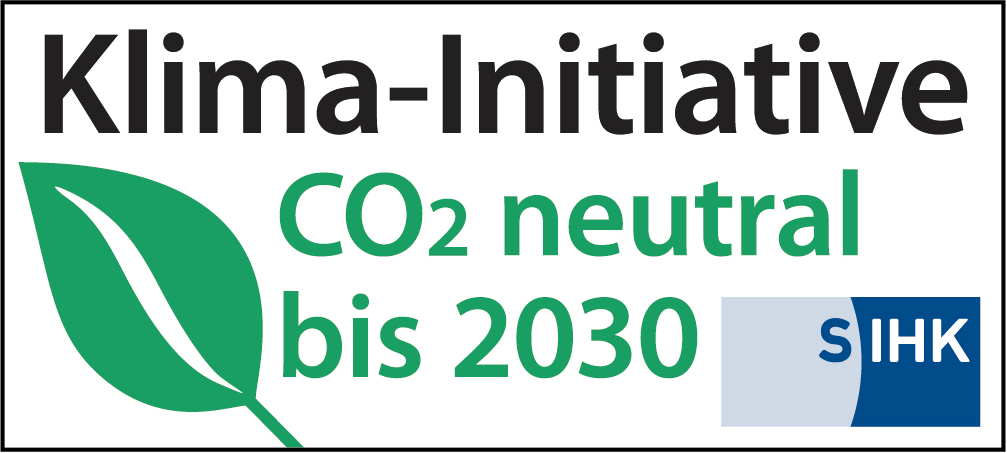
Climate protection
Pioneers in our industries –
The Westfälische Stahlgesellschaft Group is climate neutral
Climate change is one of the existential issues of our time. Therefore, climate protection is not only a task for the future, but requires consistent action in the here and now.
The Westfälische Stahlgesellschaft group of companies wants to play a pioneering role in climate protection in the bright steel production and steel trading sectors – out of conviction and responsibility for society. As of the beginning of 2021, we have made CO2 emissions in our direct sphere of influence (Scope 1 & 2) and in parts of the indirect sphere of influence (Scope 3) climate neutral at all company locations. Business operations at our value creation stage thus already leave no CO2 footprint. But that’s not all: We want to achieve further improvements in terms of climate protection through systematic efficiency and avoidance strategies within our organization and by involving our upstream and downstream value-adding partners.
The starting point for all climate protection measures is our carbon footprint, i.e. the standardized calculation of our company’s CO2 emissions in accordance with the Greenhouse Gas Protocol. The sources of emissions recorded together with ClimatePartner, a solution provider in climate protection for companies, range from heating, fuels and electricity to business trips and employee journeys to office materials and waste disposal.
Wherever possible, we try to avoid and reduce these CO2 emissions. As a first step, we have therefore switched to purchasing electricity from renewable energy plants („green electricity“) with corresponding certificates of origin, effective January 1, 2021. In parallel, we are driving forward our own generation of renewable electricity by means of photovoltaic systems on our hall roofs. However, our main focus is on the ongoing optimization of our use of resources in terms of reduction and efficiency enhancement measures. In addition to electrification options, this also includes consideration of the use of biogas or hydrogen. We continuously measure the success of our measures by means of a regularly updated CO2 balance sheet.
But no matter how much we reduce, residual emissions remain that we cannot (yet) avoid. To consistently offset our remaining CO2 emissions, we support a recognized climate protection project certified according to international standards for the promotion of clean wind energy. Further information about our specific compensation measure can be found at www.climatepartner.com/1272.
As a medium-sized, owner-managed group of companies, sustainable, responsible action is an integral part of our corporate culture. We are determined to make our contribution to greater sustainability – first and foremost in climate protection. With our CO2-neutral status, we have shown that the path to climate-neutral business is possible. We would be pleased if you would accompany our group of companies on this path.
The management of the companies
– Westfälische Stahlgesellschaft F.W. Krummenerl GmbH & Co. KG, Plettenberg
– Ziehwerk Plettenberg GmbH & Co. KG, Plettenberg
– Westfälische Stahlgesellschaft mbH & Co. Eisen- und Stahlhandel KG, Löhne
– Weser Stahl Handelsgesellschaft mbH & Co. KG, Stuhr
ClimatePartner – Our partner for climate protection
ClimatePartner (https://www.climatepartner.com) is a solution provider in climate protection for companies. ClimatePartner combines individual consulting with cloud-based software that is unique on the market. Customers can use it to calculate and reduce CO2 emissions and offset unavoidable emissions. In this way, companies become climate neutral, which is confirmed by the ClimatePartner label above.
The principle of climate neutrality
Companies are climate neutral if their CO2 emissions have been calculated and offset by supporting internationally recognized climate protection projects. In addition to avoidance and reduction, this offsetting of CO2 emissions is an important step in holistic climate protection. Greenhouse gases such as CO2 are distributed evenly in the atmosphere, so the greenhouse gas concentration is roughly the same everywhere on earth. For the global greenhouse gas concentration and the greenhouse effect, it is therefore irrelevant where on earth emissions are caused or avoided. Emissions that cannot be avoided locally can therefore be offset by climate protection projects elsewhere.
What is a climate protection project?
Climate protection projects demonstrably save greenhouse gases and make an important contribution to combating global warming. In addition, they promote sustainable development in the project countries, for example by improving the supply of clean drinking water, expanding local infrastructure, creating jobs or protecting biodiversity.
A globally recognized yardstick for measuring these positive effects is provided by the Sustainable Development Goals (SDGs) of the United Nations. These 17 goals include combating poverty and hunger, promoting education, and spreading clean and affordable energy worldwide. Every climate protection project in the ClimatePartner portfolio contributes to several of these goals. To make this effect visible, ClimatePartner shows the contribution of individual projects to the different SDGs for each project. This allows you to understand which other goals the projects support in addition to climate protection. For some projects, the additional contribution is so large that, at their core, they are actually development projects with a climate protection effect – and not the other way around.
A selection of worldwide climate protection projects with background information, pictures and videos is provided by the ClimateMap (https://www.climate-project.com). There you can filter by regions, technologies, SDGs and certification standards.
Criteria for climate protection projects
All climate protection projects must meet four basic criteria in addition to emissions savings: Additionality, exclusion of double counting, permanence, and verification by independent third parties.
To demonstrate compliance with the criteria, projects are certified and verified according to strict criteria, such as the Gold Standard or the Verified Carbon Standard (VCS). This ensures and regularly confirms the climate protection impact of the projects. One of the most important requirements is that the projects are actually additional climate protection measures and that the contribution to CO2 reduction in the atmosphere can be clearly measured. The following criteria must be met by projects in order for them to be recognized as climate protection projects:
(a) Additionality
It must be ensured that a project is implemented only because it receives additional financing through emissions trading. In other words, the project must rely on proceeds from emissions trading to meet its financing needs and must be able to demonstrate this need. Projects that are economic anyway and would be implemented even without these revenues do not meet the criterion and cannot be used to offset CO2 emissions.
b) Exclusion of double counting
The project developer must ensure that CO2 savings are not counted elsewhere. For example, a solar plant whose electricity is marketed as green electricity cannot be used as a carbon offset project because the positive climate impact is already attributed to the electricity. In the climate neutrality process, it must be guaranteed that the CO2 emissions saved are only used once to offset CO2 emissions and that the corresponding certificates are set aside for this purpose.
c) Permanence
The emission savings must be permanent. This criterion is particularly important for afforestation and forest conservation projects. In these projects, it must be ensured that the forest areas will remain for a certain period of time. A forest area that becomes cattle pasture again after a few years due to slash and burn may not be recognized as a climate protection project.
d) Regular verification by independent third parties
Climate protection projects must be audited at regular intervals by independent third parties with regard to all the above criteria. They monitor compliance with the respective standards and determine the actual amount of CO2 saved retrospectively. Regular progress reports are therefore prepared for the projects.

We are a member of the climate initiative of the Southwestfalia Chamber of Commerce and Industry at Hagen (SIHK)
The reduction of CO2 emissions and the associated energy savings and efficiency increases are a necessity from an ecological and economic point of view. More and more companies in the SIHK region recognize their responsibility for global climate protection. They want to make their own contribution to climate protection and are focusing on the CO2 footprint of their products and services.
The SIHK Climate Initiative is an open network for companies that make a binding commitment to make their business location climate neutral by 2030 at the latest.



